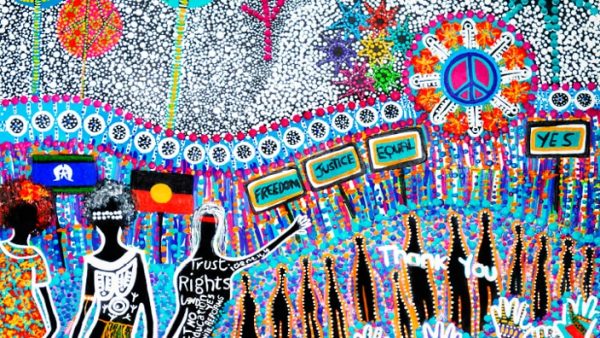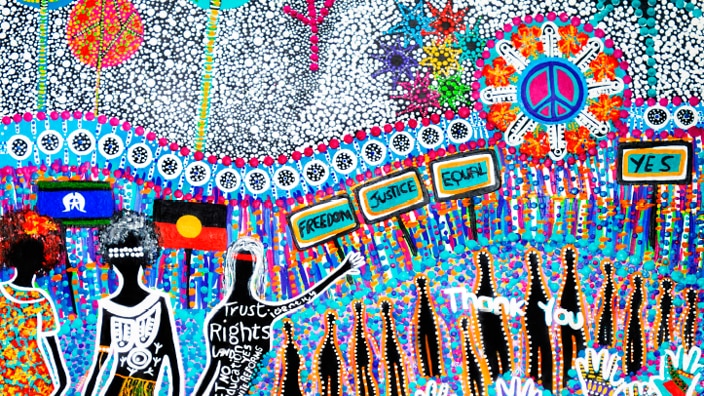
Originally published by NITV on 4 May 2018.
This year’s NAIDOC poster recognises the women who have fought for justice in our society.
Protests and peace signs feature in this year’s official NAIDOC poster. The words “Freedom”, “Equal” and “Justice” stand out from the multicoloured landscape, and a vibrant sun shines upon strong women who are fighting for their rights, maintaining resilience and keeping culture alive.
The work depicts this year’s NAIDOC theme, ‘Because of Her We Can’, which aims to recognise First Nations’ women who have, and continue to make, valuable contributions to our communities. With our history books often documenting Indigenous achievements through the work of remarkable men like Bennelong, David Unaipon, Sir Doug Nicholls, Albert Namatjira, Eddie Mabo, Vincent Lingiari and Neville Bonner, this year, the spotlight shines on our women who have played equally significant roles in Australia’s history. Barangaroo, Pearl Gibbs, Mum Shirl, Lowitja O’Donoghue, Margaret Williams Weir, just to name a few.
It’s a theme which attracted nearly 200 artists to enter its annual poster art competition —double the amount of entries received in the previous year.
Out of hundreds of submissions, Bigambul woman from Goondiwindi, QLD, Cheryl Moggs took out the major prize. Her painting sends two key messages; it celebrates the Indigenous women who have fought for justice in our society; and highlights the importance of connection to country.
With such a groundbreaking theme, self-taught artist Cheryl, felt that this was the year she should to submit one of her works to the NAIDOC poster competition. It was a time to say “thank you” to all the Indigenous female leaders, she told NITV.
“I think it’s the first time I’ve had a bit of a political spin on any of the art that I do,” she says. “I’ve never been a political advocate in a negative sense. I try to do it in a positive way and use the art to do that. It’s a way of creating awareness and educating people of our history, and to showcase the people that were involved in making change.”
In the top right corner is an sun emblazoned in oranges, yellows, pinks, purples and a peace sign. Cheryl says it sends a message to wider Australia saying, “we’re all Australians, it’s time to make peace and come together and embrace diversity.”
Her painting took just over three weeks to complete, not including the extensive research and planning beforehand.
Cheryl has worked as a teacher for many years, from early childhood to TAFEs and Universities, and recently a men’s prison. She says symbolism in art is something she drives in both personal practice and education.
“When I paint, I’m very symbolic and understand the power of our symbols. It’s something I’ve been teaching my students for a long time … it [my work] was about the three sections; how we’re connected to the sky, the land in the middle and the water. Then I have the extra bits on top telling the story. ”
By winning this year’s prestigious Poster Competition, Cheryl has received the cash prize of $10,000.
Cheryl received the celebratory news while at work. After a missed call during a meeting, Cheryl got back to the office and received another message that Jacinta from the NAIDOC committee called her. Initially thinking it was a business enquiry about funding, Cheryl said she was completely taken by surprise to hear she’d won the competition.
“I rang her and it was a total surprise because I said, ‘How are you? Do you want to talk about funding’ and she said, ‘No Cheryl, I’m here to congratulate you —well, that was a shock. I shed a tear I can tell you.”
NAIDOC committee member and one of the judges, John-Paul Janke said that Cheryl’s artwork not only stood out visually, but represented an important story, one that highlights the strong connection Aboriginal people have to country and the journey Indigenous women have endured with over time.
“It was the one the committee felt really captured the theme the most,” he told NITV.
“The NAIDOC poster sets a dialogue for how non-Indigenous people engage with NAIDOC and more generally Aboriginal and Torres Strait Islander people and culture,” he said.
With many elements featured in Cheryl’s somewhat psychedelic painting, perhaps the most curious is the sign posts —Freedom, Justice, Equality, Yes. Giving a visual history lesson, they refer to the women who marched and protested for land rights, the Freedom Ride and encouraged the public to vote “yes” in the ‘67 Referendum.
Treading below these signs are colourful footprints, imprinting the word “Connect”. Cheryl’s artist statement explains. “Our feet remain on country always. Doesn’t matter where our bodies are, we stand with our people, side by side for the betterment of our First Nations. A united force.”
Janke says that while the committee didn’t look specifically for a female artist, they saw an exciting increase entry of women artists who, like Cheryl, shared a personal connection with the theme. As such, he feels that the poster is sure to have a great impact.
The small town of Goondiwindi have already been impacted Cheryl’s work,
“All the family and all the people in this local community have been pretty amazing with the response,” says Cheryl. “We living in a region which has historically, had a lot of bad things happen here, and it’s something that’s brought people together out here.
“It’s showcased the regional and remote areas that we can actually come together and art does that justice.”
